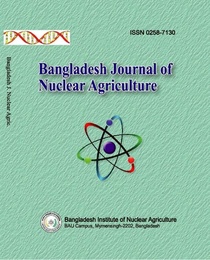IMPROVING YIELD OF SALT TOLERANT RICE VARIETIES THROUGH SILICON APPLICATION
Abstract
Climate change creates hazards like cyclone, sea level rise, and storm surge have been increasing the salinityintrusion problem in many folds of Bangladesh. High level of the salinity affectedin Rabi season therefore, current field experiment was carried out at saline prone area,Sodor, Satkhira under natural salinity condition during Rabi season 2017-2018. The experiment was carried out with two varieties namely, Binadhan-10, BRRIdhan67 and four levels of silicon with control S0: 0 kg ha-1, S1: 5 kg ha-1, S2: 10 kg ha-1 and S3: 15 kg ha-1. The experiment was laid out in a split plot design with three replications. The recommended fertilizer doses applied for the experiment were 80 kg N ha-1, 15 kg P ha-1, 50 kg K ha-1 and 20 kg S ha-1 and silicon as basal dose. Application of silicon had significant effect on plant height, number of effective tiller m-2, length of panicle, total number of spikelets panicle-1, thousand grain weights, number of filled spikelets panicle-1, grain yield and straw yield.It seems that the crop responded to the application of silicon @ 5-15 kg Si ha-1 and best dose was reported @ 15 kg ha-1 silicon followed by 10 kg ha-1. Results suggest that an application of silicon along with N, P, K, S, Zn, might be necessary to ensure satisfactory yield of rice in saline prone area under natural salinity condition.
References
Ahmad R., Zaheer S.H.&Ismail S. (1992) Role of silicon in salt tolerance of wheat (Triticumaestivum L.). Plant Science85, 43–50.
BARC. 2012. Fertilizer recommendation guide. Bangladesh Agricultural Research Council.Farmgate, Dhaka-1215.pp.80-82.
BBS. 2018. Statistical Year Book of Bangladesh. Bangladesh Bureau of Statistics, Dhaka, Bangladesh.
Gomez, K.A. and Gomez, A. A. 1984.Statistical Procedure for Agricultural Research, 2nd Ed. John Wiley and Sons, New York, USA.
Gong, H., Chen, K., Chen, G., Wang, S. and Zhang, C. 2003. Effects of silicon on growth of wheat under drought.J.. Plant Nutri.. 26(5): 1055-1063.
Gong, H. J., Randall, D. P. and Flowers,T. J. 2006. Silicon deposition in the root reduces sodium uptake in rice (Oryza sativa L.) seedlings by reducing bypass flow.Plant Cell Environ. 29(10):1970-9.
Karim, Z. andIqbal, A.2001. Impact of land degradation in Bangladesh Changing Scenario in Agricultural Land Use, Bangladesh Agricultural Research Council, Farmgate, Dhaka-1215. pp. 46–47.
Khattak, S. G., Haq, I. U., Malik, A.,Khattak, M. J. and Naveedullah 2007. Effect of various levels of gypsum application on the reclamation of salt affected soil grown under rice followed by wheat crop. Sarhad J. Agric.23: 675−680.
Ma, J. F. 2004. Role of silicon in enhancing the resistance of plants to biotic and abiotic stresses.J.Soil Sci.Plant Nutri.50 (1): 11 – 18.
Ma, J. F. and Takahashi, E.1990.Effect of silicon on the growth and phosphorus uptake of rice. Plant Soil, 126(1): 115-119.
Matoh T., Kairusmee P.&Takahashi E.1986.Salt‐induced damage to rice plants and alleviation effect of silicate.Soil Science and Plant Nutrition32, 295–304.
Mainuddin, K., Rahman, A., Islam, N. and Quasem, S.2011. Planning and costing agriculture’s adaptation to climate change in the salinity-prone cropping system of Bangladesh.International Institute for Environment and Development (IIED), London, UK.
Mukkram, A. T.,Rahmatullah, T. A., Muhammad, Y. A., Shaista, K. and Aamer M. 2006. Beneficial effects of silicon in wheat under salinity stress. Pakistan J. Bot. 38(5):1715-1722.
Rashid, A., D. Harris, Hollington, P.A. and Khattak, R.A. 2002. On farm seed priming: A key Beneficial effects of Silicon in wheat (Triticumaestivum L.) under salinity stress. Pak. J. Bot. 38(5): 1715-1722.
Russell, D. 1968. MSTAT-C PakageProgramme.Crop and Soil Science Department, Michigan University, USA.
Singh, K., Singh, R.,Singh, J.P.,Singh, Y. and Singh, K.K.2006. Effect of level and time of silicon application on growth, yield and its uptake by rice (Oryza sativa). Indian J. Agric.Sci.. 76(7): 410-413.
SRDI.2003. Soil salinity in Bangladesh. Soil Resource Development Institute, Ministry of Agriculture, Dhaka-1215. pp. 90-91.
Takahashi, E. 1968.Silicon as a nutrient to the rice plant.Japan Agric. Res. Quarterly. 3(3): 1-4.
World Bank. 2013. Turn down the heat- why a 40C warmer world must be avoided. A Report for the World Bank by the Potsdam Institute for Climate Impact Research and Climate Analytics.The World Bank, 1818 H Street NW, Washington DC 20.
Yasmine, F., Hossain, M. M., Mazumder, M. N. N.,Rahman, M. H. and Rahman, M. A. 2011.Effect of salinity levels on growth and yield of advanced mutant rice genotypes in Boro season. J. Bangladesh Society for Agric. Sci. Technol.8(1&2): 23–28.
-
Download



